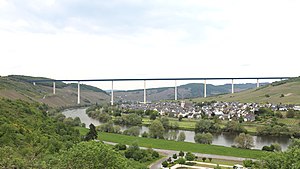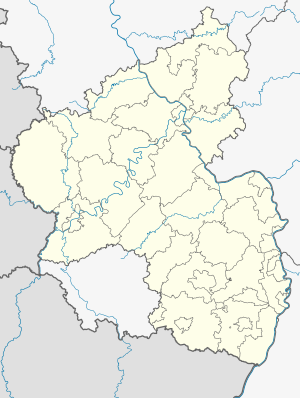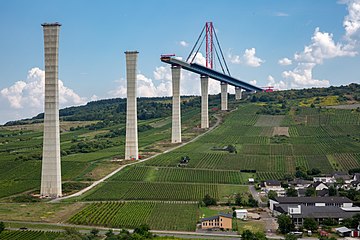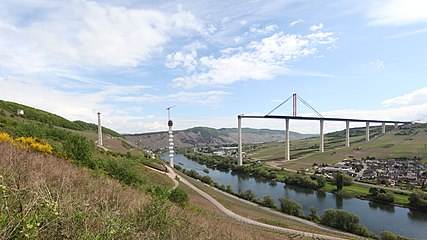Hochmosel Bridge
Coordinates: 49 ° 58 ′ 7 ″ N , 7 ° 0 ′ 0 ″ E
| Hochmosel Bridge | ||
|---|---|---|
| The bridge in May 2019 | ||
| Official name | Building 6008 860 (BW 20) | |
| use | Road bridge | |
| Convicted | Bundesstrasse 50 | |
| Crossing of | Moselle | |
| Subjugated | Federal road 53 L189 | |
| place | Ürzig ↔ Zeltingen-Rachtig | |
| construction | Steel girder bridge | |
| overall length | 1702.4 m | |
| width | 29.0 m | |
| Number of openings | 11 | |
| Longest span | 209.5 m | |
| height | 158 m | |
| building-costs | approx. 175 million euros | |
| start of building | Fall 2011 | |
| completion | November 2019 | |
| opening | November 21, 2019 | |
| construction time | 8 years | |
| planner | State Office for Mobility Rhineland-Palatinate | |
| location | ||
|
|
||
The Hochmoselbrücke is a road bridge in the course of the Hochmosel crossing in Rhineland-Palatinate , which was opened to traffic on November 21, 2019. It leads the federal highway 50 with four lanes and two hard lanes over the deeply cut Moselle valley between Ürzig and Zeltingen-Rachtig at a maximum height of 158 m. The Moselle will be crossed at river kilometer 120.8 as well as the federal highway 53 and the federal highway 189. The construction costs amounted to around 175 million euros.
history
There were already plans to build a high Moselle crossing in the 1960s. 2009 reported the ZDF magazine Frontal 21 , that the plans to Heinrich Holkenbrink (CDU) go back to the 1971-1985 Rhineland-Palatinate Minister of Economy and Transport and was from 1966 to 1984 Chairman of the CDU district Trier. Holkenbrink wanted a troop deployment route to connect the North Sea ports with the military airfields in Eifel and Hunsrück and the Rhine-Main area . However, the project was rejected by the then Federal Transport Minister Georg Leber (SPD) for reasons of cost and only included in the new trunk road expansion law in 1971 when a motorway connection was planned from Liège via Wittlich to the Rhine-Main area (today's A 60 and B 50) .
On April 30, 2010, the tender for the construction project based on a design from the beginning of the 21st century was announced. Offers had to be submitted by September 7, 2010. The contract was awarded on December 16, 2010 to a consortium consisting of the French construction company Eiffage , its subsidiary Eiffel Deutschland Stahltechnologie and Porr Germany, with an order value of 108 million euros net and 128.5 million euros gross. After the contract was awarded, the bridge should be completed within 54 months. The creation and examination of the construction documents for the bridge, however, required a higher expenditure of time and resulted in a later start of the construction work.
Additional costs of 46.7 million euros became known in autumn 2014. The main reason for this was an additional requirement of 7500 t of steel, which had to be built additionally due to changed standards.
After the structural work was awarded at the end of 2010, the earthworks for the access began in 2011. The drilling work for foundation piles on the eastern side began at the end of October 2012 and in January 2015 the drilling work followed on the western side in the steep Ürziger scree slope. Completion and opening was originally planned for 2016.
In spring 2016, an additional six dowel shafts (anchored shaft structures) were put out to tender to secure the slope. The dowel shafts should have a diameter of 6 m and a 1 m wall thickness of around 40 m. The total order value of the dowel shafts was 8.9 million euros gross.
construction
The bridge is constructed as a 1702.35 m long girder bridge with a steel superstructure and a 29.0 m wide orthotropic deck . In the longitudinal direction it has the continuous girder as a building system and eleven fields with spans of 104.76 m, 130.95 m, 157.14 m, 209.52 m, 196.43 m, 183.33 m, 170.24 m, 157 , 14 m, 144.04 m, 130.95 m and 117.85 m. In the transverse direction there is a hollow box cross-section with a construction height of maximum 7.78 m in the area of the large spans and 5.268 m at the eastern abutment . The cantilevered carriageway slab is supported by inclined struts at a distance of 13.095 m. The roadway is in a straight line. In the area of the bridge, the gradient has a changeable longitudinal gradient that falls towards the Eifel side.
The ten reinforced concrete pillars have heights of 20.78 to 150.72 m from the top of the pile head. In the longitudinal direction of the bridge, the piers have a dimension of 3.9 m at the pier head. Due to a linear suit of 80: 1 upwardly a length of about 7.5 is obtained at the highest support below m. In the transverse direction of the bridge, the pier dimensions are 12 m at the pier head. The width of the short pillars is reduced downwards, the long pillars are waisted according to a cubic parabola. This has a minimum width of 9.5 m for the highest pillar and increases again to 16.0 m at the pillar base. Around 30,000 m³ of concrete and 4,000 t of reinforcing steel were tendered. In total, more than 32,000 t of steel was used for the bridge.
The pillars were founded with large bored piles . These had to be made on the western side in the steep Ürziger scree slope, which is characterized by fossil landslides .
Construction work
The pillars were made with self- climbing formwork in 5 m high sections. The completion of a section took between ten and fourteen days. During construction, scaffolding cubes were placed on the high pillars to disrupt wind turbulence. This caused a reduction in the force of gusts of wind. The transport of people and all of the material was carried out on the high pillars with a climbing crane with a radius of 40 m and a maximum load-bearing capacity of 12 t. With a maximum hook height of 163 m, the cranes were guyed up to three times on the pier.
The steel bridge superstructure with a mass of 25,000 t was assembled using the incremental launching method . To this end, the steel superstructure at the Hunsrück abutment was assembled in 82 sections and pushed in section by section. The shunting systems were installed on the abutment and also on the pillars that had been driven over. Cantilever arm lengths of up to 210 m occurred during insertion. In order to limit the cantilever moments and deformations, the superstructure was provided in the first 90 m long section without lateral cantilevers and also with a pylon span. The pylon is 80 m high.
The first shift of a total of thirteen cycles took place in autumn 2013 with a length of 83 m on the pre-assembly area. In June 2014, the second cycle followed with 118 m. After installing the pylon, the third shift took place in June 2015. The fourth shifting phase of the steel superstructure was completed in September 2015. It lasted almost two weeks and after the first 39 m it crossed pillar 9. As before, a further 118 m were inserted; the steel superstructure came to a halt about 69 m in front of pillar 8. The next steps, each crossing a bridge field, followed every four months. In November 2017, the eleventh phase was carried out with the crossing of the Moselle and the maximum cantilever length of 210 m. The last bridge shift took place on August 24, 2018.
reception
On November 16, 2019, between 8,000 and 10,000 visitors came to a public festival on the completed, but not yet open to traffic bridge. The Hochmosel Bridge was opened to traffic on November 21, 2019.
The construction of the Hochmosel Bridge was, however, controversial. Critics complained that they destroy the landscape of the Moselle valley without promoting the Hunsrück permanently. It would also affect some of the best Moselle vineyards. Wine connoisseurs like Hugh Johnson therefore spoke out publicly against the building. The Bündnis 90 / Die Grünen party also initially rejected the building. In the coalition negotiations after the state elections in 2011 , however, the SPD and the Greens agreed to implement the project. At the end of 2012, a petition from March 2010 with 5,104 signatories against the building project was under parliamentary scrutiny by the petitions committee of the Bundestag .
In December 2013, Der Spiegel reported that the Rhineland-Palatinate State Office for Geology had warned of “geological slide surfaces” at the valley edges that went up to 70 m deep, “were not safely explored” and endangered the stability of the bridge. The Rhineland-Palatinate Ministry of the Interior, for Sports and Infrastructure , which is superordinate to the State Office , contradicted: Both in the planning phase and during construction, intensive soil explorations were continuously carried out. For example, there were around 180 boreholes, some to a depth of 70 m. The director of the state office stated against it that a hydrogeological report was missing. The ministry thereupon commissioned an additional report to secure previous knowledge, which was available in June 2014. The office responsible for geotechnical engineering assessed the results of the hydrological report as positive. Compared to the previously used parameters, they even tended to lead to more favorable input values for the stability calculations.
Because of security concerns of the Aachen-based engineering geologist Rafig Azzam, the citizens' initiative Pro Mosel filed a criminal complaint at the beginning of December 2014 because of building risk . After examining the possible criminal offense, the Trier public prosecutor announced in mid-January 2015 that it would not start an investigation, as there were no indications of criminal behavior. At the beginning of 2015, the geotechnical expert Rolf Katzenbach was called in and in spring 2016 six additional dowel shafts were put out to tender.
See also
watch TV
- Bobby Cherian: Bridge XXL - dispute over the Hochmosel crossing. Documentation, approx. 30 min., ZDFinfo 2016
- Susanne Gelhard, Bobby Cherian: Bridge XXL - mega-structure Hochmoselbrücke. Documentation 30 min., ZDF report on November 24, 2019
literature
- Joachim Naumann ( Federal Ministry of Transport ): “Strelasund Crossing and High Moselle Crossing” - First major projects as an operator model. Bridge Construction Symposium Dresden 2003 (PDF file; 657 kB)
Web links
- B50 - High Moselle crossing. State Office for Mobility Rhineland-Palatinate
- Pro Mosel citizens' initiative against the high Moselle crossing
Individual evidence
- ↑ costs / schedule. In: B50 Hochmosel crossing. Retrieved November 22, 2019 .
- ↑ a b High Moselle crossing open to traffic - Europe's largest bridge construction site will be finished soon. In: hochmoseluebergang.rlp.de. Landesbetrieb Mobility Rhineland-Palatinate, September 23, 2019, accessed on October 3, 2019 .
- ^ Wit / dpa: Completed Hochmosel Bridge. "That's impressive when you stand on it". In: Panorama. " Der Spiegel " magazine online (SPON), November 16, 2019, p. 1 , accessed on November 16, 2019 .
- ^ Andreas Halbach: Expensive Moselle Bridge - construction project endangers viticulture. (PDF file) pro-mosel.de, accessed on May 12, 2014 .
- ↑ Network plan 1972. German Bundestag, Annex to the road construction report 1972, map "Construction work on the federal highways in 1972", autobahn-online.de.
- ↑ Steel constructor Eiffel from Hanover builds Germany's largest steel bridge. In: Hannoversche Allgemeine Zeitung, December 28, 2010.
- ↑ 2010 / S 244-372267 Announcement about awarded contracts, December 7, 2010. Landesbetrieb Mobility Trier.
- ↑ EC announcement (03/10). (PDF file) (No longer available online.) Archived from the original on January 3, 2014 ; Retrieved on June 6, 2010 (public tender for the production of structure 6008 860 (BW 20) - Hochmosel crossing in the train of the B 50 new, BA Platten - ZB B 53). Info: The archive link was inserted automatically and has not yet been checked. Please check the original and archive link according to the instructions and then remove this notice.
- ↑ a b Ministry admits delay at Hochmosel bridge. In: Die Welt, January 9, 2013.
- ↑ Small question from the MP Jutta Blatzheim-Roegler (Bündnis 90 / Die Grünen) and answer from the Ministry of the Interior, for Sports and Infrastructure, Landtag Rhineland-Palatinate, printed matter 16/1856. (PDF file)
- ↑ Higher construction costs, more steel required Why the Hochmosel crossing devours 81 million euros more than calculated. In: pfaelzischer-merkur.de, September 12, 2014.
- ↑ Hans-Gerd Öfinger: attacking the major projects. In: Neues Deutschland , March 24, 2011.
- ↑ Well then: drilling work on the Hochmosel bridge. In: Rhein-Zeitung, January 6, 2015.
- ↑ Report on additional costs in the Eifelhang completely exaggerated. ( Memento of the original from March 5, 2016 in the Internet Archive ) Info: The archive link was inserted automatically and has not yet been checked. Please check the original and archive link according to the instructions and then remove this notice. In: landeszeitung-rlp.de, March 5, 2016.
- ↑ Announcement of awarded contracts. Tenders-Deutschland.de, accessed on October 3, 2019.
- ↑ a b c Michael Hagedorn, Uwe Heiland, Thomas Klähne: The High Moselle Bridge - Manufacture, assembly and planning of the steel superstructure. Stahlbau 2015, Issue 2, pp. 85-103.
- ↑ Call for tenders: Construction work for bridges, Document No. 137902-2010 (ID: 2010051204092700074), published on May 12, 2010.
- ↑ https://www.stahl-online.de/index.php/hochmoselbruecke-vor-eroeffnung-mehr-als-32-000-t-stahl-verbaut/
- ↑ Joachim Naumann: "Strelasundquerung and Hochmoselübergang" - First major projects as an operator model. Bridge building symposium Dresden 2003, p. 51.
- ↑ a b Bernd Winkler: Occasion, concept and execution; Construction of the Hochmosel Bridge. Bridge construction, 1/2; 2015.
- ↑ Press release: Wolffkran is building the largest bridge project in Europe ( Memento of the original from July 11, 2016 in the Internet Archive ) Info: The archive link was inserted automatically and has not yet been checked. Please check the original and archive link according to the instructions and then remove this notice. . November 10, 2014. (PDF file)
- ↑ Feed phases. hochmoseluebergang.rlp.de.
- ↑ Celebration for everyone to close the gap between Hunsrück and Eifel. In: volksfreund.de, August 24, 2018, accessed on August 25, 2018.
- ↑ End of a mega road construction project. Thousands celebrate on the Hochmosel Bridge. In: swr.de. November 16, 2019, accessed November 16, 2019 .
- ^ The giant bridge - opening of the controversial Hochmosel crossing. In: SWR extra, swr.de. November 21, 2019, accessed November 21, 2019 .
- ↑ [1] b50neu.de.
- ↑ Dietmar Brück: Red-Green is committed: The Hochmosel Bridge is coming - and the cabinet is in place. In: Rhein-Zeitung . May 2, 2011.
- ^ German Bundestag: Petition: Bundesstraßen - Construction stop for the so-called Hochmoselübergang from 09.03.2010.
- ↑ Slipping pillars? In: Der Spiegel, issue 52/2013, December 21, 2013, p. 14.
- ↑ Hochmosel crossing: Ministry sees no risk in bridge construction. SWR Landesschau aktuell, December 20, 2013.
- ↑ State geologists: There are still no reports for the construction of the Hochmosel bridge. In: Rhein-Zeitung.de, December 28, 2013.
- ↑ Ministry of the Interior, for Sport and Infrastructure of the State of Rhineland-Palatinate: Expert opinion on the hydrogeological and water balance situation on the western slope of the bridge route of the Hochmosel crossing ( Memento of the original from February 15, 2015 in the Internet Archive ) Info: The archive link was automatically inserted and not yet checked. Please check the original and archive link according to the instructions and then remove this notice.
- ↑ Construction project in Rhineland-Palatinate: Doubts about the stability of the Hochmosel bridge. In: Der Spiegel, November 30, 2014.
- ↑ No investigation into the construction of the Hochmosel Bridge. In: Allgemeinebauzeitung.de, January 26, 2015.
- ↑ Hochmosel Bridge will be much more expensive - the slope has to be secured. In: volksfreund.de, March 5, 2016.
- ↑ Youtube video of the broadcast (28 min.)
- ↑ ZDF video, available until November 22, 2020







